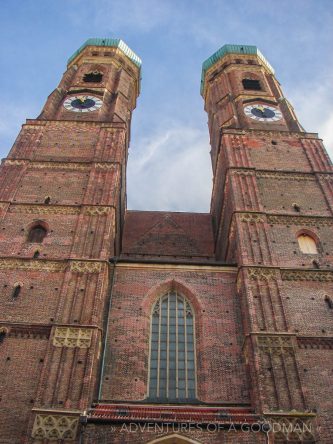The Frauenkirche, which translates to the Cathedral of Our Dear Lady, is a church located in the Bavarian city of Munich.
It serves as the cathedral of the Archdiocese of Munich and Freising and seat of its Archbishop. Frauenkirche is a landmark and is considered a symbol of the Bavarian capital city.

About the Frauenkirche
The church towers are widely visible because of local height limits. The city administration prohibits buildings with a height exceeding 109 metres (358 ft) in the city center.

Since November 2004, this prohibition has been provisionally extended outward and as a result, no buildings may be built in the city over the aforementioned height.
The south tower is open to those wishing to climb the stairs and offers a unique view of Munich and the nearby Alps.
A History of the Frauenkirche
According to Wikipedia:
The cathedral, which replaced an older romanesque church built in the 12th century, was commissioned by Duke Sigismund and erected by Jörg von Halsbach. For financial reasons and due to the lack of a nearby stone pit, brick was chosen as building material. Construction began in 1468. Since the cash resources were exhausted in 1479 Pope Sixtus IV granted an indulgence.
The two towers were completed in 1488 and the church was consecrated in 1494. However, the building’s famous domes atop each tower were not added until 1525.
Their design was modeled on the Dome of the Rock in Jerusalem, which in turn took a lead from late Byzantine architecture. The cathedral suffered severe damage during World War II — the roof collapsed and one of the towers suffered severe damage. A major restoration effort began after the war and was carried out in several stages, the last of which coming to an end in 1994.
. . .
Please enjoy the Bavaria, Germany, photo gallery
EXPLORE SOMEWHERE NEW
BUY A PRINT
All photos on this site are available as limited edition fine art photographic prints. Please get in touch for sizes and rates.


